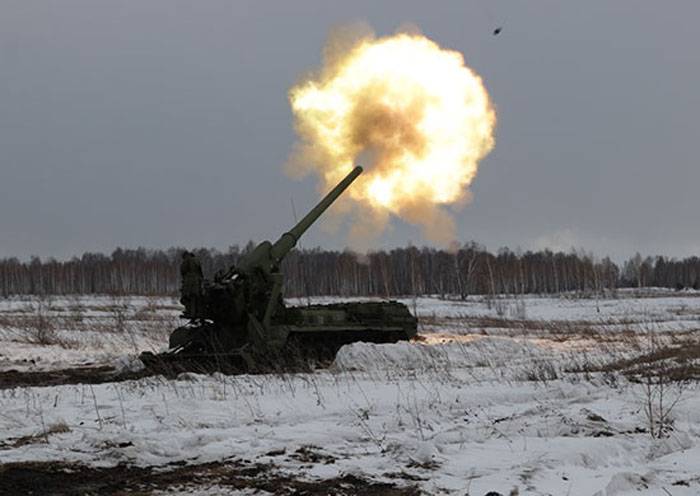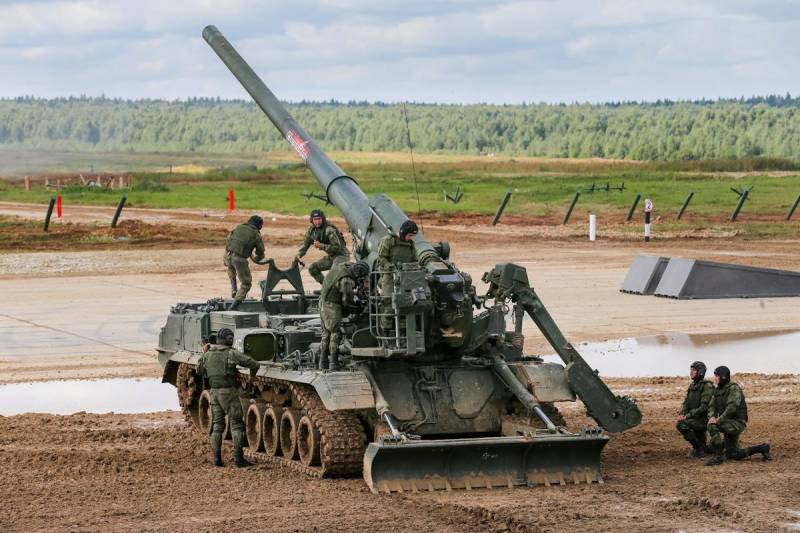SAU 2C7M "Malka". Old novelty for the army
On the delivery of new technology, the press service of the Central Military District reported on Monday 25 June. According to the official report, one of the artillery units of the district, stationed in the Kemerovo region, received a divisional kit of new equipment. As part of the state defense order of the army, a batch of 12 self-propelled guns was transferred. Also, the report cited some technical data directly related to obtaining high combat effectiveness.
According to official information, recently transferred self-propelled guns in the very near future will go to the landfill for shooting. In July, a field camp of the Central Military District gunners will be held at the Yurginsky range (Kemerovo region). As part of this event, the Malok crews will have to reach the firing line and execute firing at training targets. However, the details of future exercises have not yet been clarified.
The recent delivery of a divisional set of self-propelled guns can have a noticeable effect on the potential of high-powered Russian artillery. According to available data, until recently, the artillery units of the Russian army had 60 combat vehicles of the 2C7M type. The supply of 12 units of such equipment is essential, both in terms of quantity and in terms of the resulting potential. In fact, now the army has even more tools for solving particularly complex and important tasks.
It should be recalled that the self-propelled gun 2С7М "Malka" is a modernized version of the older combat vehicle 2С7 "Peony". The latter was created in the early seventies, and in 1975-m entered the armament of separate battalions of artillery brigades of high-power artillery from the reserve of the High Command. To solve special combat missions, the Peonies could use 203-mm projectiles of various types, including two types of products with nuclear warheads. Depending on the type of projectile used, the firing range reached 45-47 km.
Almost immediately after the adoption of the Pion, the development of its improved version began. The result of this work was an order to start the production and operation of the 2C7М “Malka” self-propelled guns, which appeared in the 1986 year. Initially, the new SAU were to complement the existing equipment, and then gradually replace it. From the point of view of the organizational structure, the service of the new “Malka” did not differ from the operation of the “Pion”. At the same time there was a curious event. In the early nineties, in compliance with the terms of the Treaty on Conventional Arms in Europe, Russia was forced to transfer all high-power ACSs to the eastern regions, outside the European part of the country. There the technique remains to this day and regularly participates in combat training activities.
At the time of adoption, the 2C7 combat vehicle, in general, met the requirements of the time, but soon the military demanded that it be upgraded, resulting in an SAU 2C7M. First of all, in the new project provided for the replacement of the engine. The Mulco uses a multi-fuel B-84B engine with 840 horsepower. vs xnumx hp at "Peony". Were also finalized engine compartment and chassis. The chassis was equipped with routine control equipment that monitors the status of all major systems and components. All these changes have led to a significant increase in the resource of the motorcycle race.
The artillery part of the combat vehicle was notably refined. The 2А44 gun remained the same, but it was supplemented with several new devices and instruments. So, by optimizing the internal volumes of the corps, it was possible to double the payload. "Malka" carries 8 shots of separate loading with a propellant charge in the cards, although for a long shooting, like the "Peony", it needs to be supplied with ammunition by other transport. An improved loading mechanism appeared, which ensures that the projectile is loaded and charged into the chamber at any angle of elevation of the weapon. This allowed 1,6 to increase the rate of fire.
The most important innovation of the 2C7M Malka project has become new communication, control and monitoring devices. Instruments for receiving data from a senior battery officer appeared at the commander’s and gunner’s workplaces. Digital information is received and processed automatically, and then the consoles display the necessary data. The presence of such devices simplifies and accelerates the process of deployment to the position, and also allows you to quickly roll up and leave after the shooting. For aiming tools, as in the base sample, sector-type mechanisms with hydraulic and reserve manual drives are used.
“Malka” retained the 203-mm rifled gun of the type 2А44 with a barrel with a length of 55,3 caliber and a piston gate. With the help of a hydraulic brake recoil and a pair of pneumatic knurling the barrel is fixed on the swinging cradle. There is a pneumatic balancing mechanism. Due to the high power of the gun and the corresponding recoil, the chassis is equipped with a folding coulter that transmits a pulse to the ground.
The maximum rate of fire of the 2А44 gun on the 2С7М self-propelled gun is determined by the 2,5 shot per minute. Mode rate of fire - 50 shots per hour. The firing characteristics mainly depend on the type and parameters of the shot used. At the same time, regardless of the used projectile, "Malka" has significant advantages over other domestic self-propelled artillery installations.
Three types of high-explosive fragmentation projectiles are available for use with the 2А44. The 3OF34 "Albatross" weighs 110 kg and carries an 17,8 kg explosive. The 43-kg propellant type 4-3-2 is capable of sending it over a distance of more than 37 km. There is also an active-missile projectile 3OF44 "Burevesnik-2". With a mass of 102 kg, it carries 13,3 kg of explosives and is able to fly 47,5 km. It is also possible to use two types of shots with the ZONNNXX cluster projectile. Such 14 kg products carry 110 submunitions with 24-gram high-explosive charges. The firing range is 230 and 30 km, respectively.
The 3VOX34IN and 3VOX42IN shots with the 3OF43IN inert projectile and various charges are used to train the calculations. According to their characteristics, inert ammunition correspond to the main combat ones. Designed blank shot 4X47.
Even at the stage of drawing up the technical specifications of the ACS Pion and Malka, they were able to use artillery shells with a nuclear warhead. Later 203-mm projectiles of the “Castor”, “Sapling” and “Perforator” types were developed. The first two products entered service and went into a series, while the third did not go out of the stage of development work. According to different data, the shells for the Pion / Malki had a capacity of no more than a few kilotons. In this case, a similar tactical nuclear weapon could most seriously affect the results of the artillery strike and affect the course of the fighting.
In terms of technical and combat characteristics, the self-propelled 2C7М “Malka” is currently one of the most advanced models of its class both in our country and in the world. If the characteristics of mobility and mobility, this machine is almost no different from other self-propelled guns of the last decades, then in terms of combat qualities only a few samples from all over the world can compare with it.

Depending on the type of projectile used, the maximum firing range of the Malki reaches 45-47 km. At the same time very heavy shells with a powerful explosive charge are delivered to the target. The use of a new loading mechanism has led to a reduction in recharge time and a significant increase in the rate of fire in comparison with the base Peony.
According to the regulations, the calculation of a six-person 2X7 self-propelled gun must arrive in 7 minutes after arriving at the position. Self-propelled self-propelled ammunition consists of 8 shots, another 40 projectiles and charges are transported on a separate machine. The prepared calculation can make up to 50 shots per hour. The transition to the traveling position requires no more than 5 minutes.
It is easy to calculate that the deployment process, the use of available ammunition in the form of a single load of transport and departure from the position in the case of "Malka" take only 65-70 minutes. In this case, most of the time is spent precisely on shooting at the designated targets, including those located at a considerable distance. Using shells such as 3OF43 "Albatross", during this time the combat vehicle is able to bring down more than 850 kg of explosive on the enemy’s head, not counting several tons of metal fragments. Actively-reactive ammunition 3OF44 carry less charge, but in this case almost 640 kg of explosives will fall on the target in total.
Thus, in range 2С7М “Malka” surpasses all existing domestic guns. In terms of power, only a 240-Tulip 2-4 self-propelled 2-mm mortar can be compared to this machine, but it seriously loses in the firing range. As a result, self-propelled guns 7С2 "Peony" and 7СXNUMXМ "Malka" are the most powerful and effective samples of artillery weapons in the Russian army.
The Russian Armed Forces continue to operate several dozen self-propelled guns of high power, and are not going to abandon such systems yet. Moreover, from time to time the army gets new combat vehicles, as it was recently in one of the units of the Central Military District. In the event of a real collision with the enemy, such artillery systems will have to complement other self-propelled and towed guns. First of all, they must solve problems that are beyond the capabilities of other ACS.
Despite the limited number, 2C7М Malka self-propelled guns are of particular importance for the Russian ground forces. They are able to significantly increase the area of responsibility of the barrel artillery, as well as bring a particularly powerful blow at the enemy, including with the use of special ammunition. This technique is in service for more than three decades and it will serve in the near future. There is no replacement for existing ACSs with 203-mm guns, and it’s not clear whether it will appear at all. This means that the "Peonies" and "Malki" will remain in the ranks and will continue to contribute to the country's defense.
On the materials of the sites:
http://mil.ru/
http://ria.ru/
http://arms-expo.ru/
http://russianarms.ru/
http://nevskii-bastion.ru/
https://defence.ru/

Information